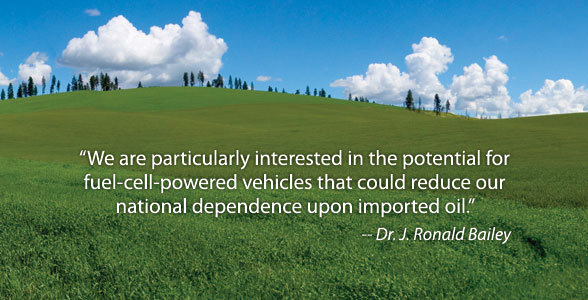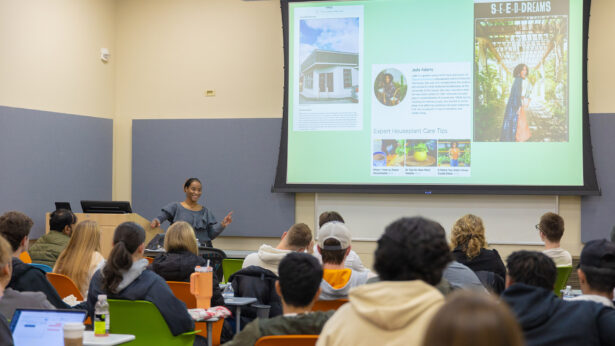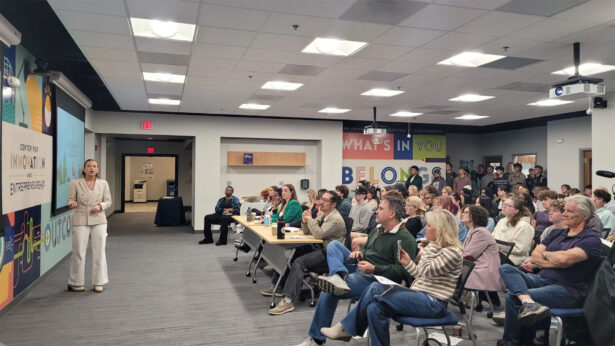Four decades ago, as millions of little Americans watched The Jetsons cartoons on television, they imagined their coming-of-age vehicle would not take to the highway but instead fly through the clouds.
It really was just a cartoon fantasy. Today those adult baby boomers are breathing unsavory air as gas-guzzling trucks, SUVs, and cars merge onto congested highways to engage in the daily rush-hour battle. Our transportation culture is ripe for change, but can we hope for anything better?
UT Chattanooga is responding to the need with new research. A fuel-cell project and a newly acquired test track for electric vehicles will assist in the quest for alternative energy strategies. “Many people have now come to understand that energy independence is directly linked to national security,” says Dr. J. Ronald Bailey, dean of the College of Engineering and Computer Science. “In addition, there is a growing body of evidence that air pollution from burning hydrocarbon fuels may be contributing to global warming. The technologies that we want to develop have the potential to have a positive impact on both of these issues, while perhaps creating a whole new transportation industry with the accompanying economic benefits that flow from innovation.”
UTC partnered with several other entities to bring the fuel-cell project to the campus. Local, state, and federal government leaders collaborated with the UT SimCenter at Chattanooga to engage Ion America of Silicon Valley, which has brought its fuel cell to the UTC campus for testing. UTC’s Alternative Energy Lab performed a field demonstration using the fuel-cell prototype and tested the system’s overall functionality and reliability. The fuel-cell installation was configured to efficiently produce hydrogen and electricity simultaneously at the point of use, which provides a safe early pathway to hydrogen production without requiring transportation or distribution infrastructure. Furthermore, solid-oxide fuel cells like the unit at UTC can use any hydrocarbon as fuel–gasoline, ethanol, methane, propane, butane–which eliminates the need to store compressed hydrogen.
U.S. Representative Zach Wamp said the fuel-cell project plays a significant role in the future of Chattanooga, a future that he and others believe will hold manufacturing related to energy and alternative transportation. “A solid-oxide fuel-cell system will someday be able to make electricity and also use that electricity to heat and cool a home and make hydrogen for your car without the need for transmission lines coming into your home,” Wamp says. “Similar fuel-cell units have proved to be nearly twice as efficient in producing electricity as a conventional coal- or gas-fired electric power plant.”
The unit is expected to cost the same as a diesel-powered generator per kilowatt. Ultimately the goal for Chattanooga is to become a site where the fuel cell units are commercially manufactured. Production is expected several years in the future.
News of the fuel cell was shared with hundreds of visitors who attended the 2006 Tennessee Valley Corridor Summit, held in Chattanooga last spring. The Tennessee Valley Corridor extends from north Alabama through Tennessee and on into southwest Virginia and southern and eastern Kentucky. With the 2006 Chattanooga Summit focused on technologies targeted to boost U.S. energy independence, a ceremony was held to unveil another campus link to alternative fuels research. The announcement revealed a new agreement to use the Tennessee Valley Authority test track and research facility in Chattanooga for electric vehicles.
TVA gave UT Chattanooga and Advanced Transportation Technology Institute (ATTI), UTC’s research partner on electric vehicle technologies, 10-year use of the facility with time-extension options. This research consortium will bring a renewed mission to the electric vehicle facility at TVA’s Chickamauga Dam location. Researchers will study fuel efficiency, endurance, and steering, along with performance variables in electric vehicles. The site could be used to test individual components and systems, as well as finished vehicles, offering the potential to work with major automobile manufacturers.
“We are particularly interested in the potential for fuel-cell-powered vehicles that could reduce our national dependence upon imported oil,” Bailey says. “Through our partnerships with ATTI and UTK, we hope to turn the TVA test track into a demonstration site for hydrogen-powered vehicles, especially those that use fuel-cell technology.”
The 52-acre facility with its 1-mile test track is an ideal location for evaluating prototype vehicles of all types, says Bailey. “It is important for UTC to be involved in this type of research in order to give our students hands-on experience with advanced energy-conversion technology,” he says. “As the nation moves toward energy independence, a new generation of engineers and scientists will be assuming leadership positions in development of this technology. We want our students to be prepared to participate fully in these opportunities. It is also important for the state of Tennessee to get on board the ‘hydrogen highway’ to gain the economic advantages that will come from the development of new industries and jobs that flow from innovation.”
As the UTC College of Engineering and Computer Science moves forward, research infrastructure is needed to compete at the national level for research grants and contracts. “Long term access to the TVA test track will give us a unique asset that will make us competitive with other universities, while also making us more attractive as a partner in the large-scale multi-institutional research programs that will be necessary for the nation to reach energy independence,” Bailey says.
In the short time the university has had access to the facility and test track, there has been an exciting transportation development in Chattanooga. A limited-liability company, EVamerica, has been created to design, develop, manufacture, and assemble medium- to heavy-duty electric, hybrid-electric, and fuel-cell vehicles. EVamerica will have four divisions: vehicle manufacturing and assembly, propulsion system manufacturing and assembly, research and development, and power system devices.
“It is the intent and expectation of both ATTI and EVamerica that a strong working relationship will persist,” says John Woodrow Powell, president and chief operating officer of EVamerica and former executive director of ATTI. Jim Frierson, ATTI’s new executive director, will work closely with EVamerica to design, develop, test, and deploy advanced-technology vehicles.
Previous advanced-technology vehicle manufacturers, in Chattanooga and elsewhere, have not had easy opportunity to test modifications and upgrades on the vehicles they produced. EVamerica recognizes the advantage of the TVA test track and UTC’s access to it: “EVamerica would have been created with or without the test track,” Powell says. “But the existence of the test track and the ability of ATTI and UTC to access the facility and track provide an astronomical benefit to EVamerica, or any vehicle manufacturer who understands that the baseline testing of its vehicles is a powerful competitive asset.”
Powell says vehicle manufacturers recognize that differences in operation, grades, and weather can affect how advanced-technology vehicles perform. Simply designing a bus to operate for 90 miles, for instance, does not mean that it will. “However, knowing that the bus actually can operate for 90 miles gives EVamerica the ability to better address the differences between the test facility and other locations, which ensures that those purchasing these vehicles are not oversold. The test facility and track, along with faculty and students through the Advanced Technologies for Transportation Research Program, may make the difference between a successful or an unsuccessful EVamerica,” Powell says.
When EVamerica was created, Powell says early discussions reflected an understanding that ATTI and UTC, through the Advanced Technologies for Transportation Research Program and with the Chattanooga Area Regional Transportation Authority, would be critical in the development and growth of the manufacturing organization. “In the very first meeting, as the concept of recreating an electric bus manufacturer was discussed, ATTI, UTC, and CARTA [the Chattanooga Area Regional Transportation Authority] were mentioned more than a dozen times,” Powell says. EVamerica, with those partners and others throughout the Chattanooga area, can become a major player in advanced-vehicle technology manufacturing and assembly, he says–an effort that would be significantly more difficult without ATTI, UTC, and CARTA.



